Do you know how to make a meal plan and use it to efficiently grocery shop?
How about for longer periods of time?
I’m not talking just for a week.
Do you think you could go to the store this weekend and buy everything your family would need for 1 month? 2 months?
If not, I hope that I can help you learn how to create a meal plan that makes the most out of each shopping trip.
I recently went through this myself with the shelter in place order due to coronavirus.
I don’t want to get caught up in any of the politics related to the virus.
But what I DO want to share with you are the steps our family has taken to prepare.
Specifically, how I made a meal plan to feed our family for the next two months and used it to buy all of the food we will need in one shopping day (and lots of prep days since!).
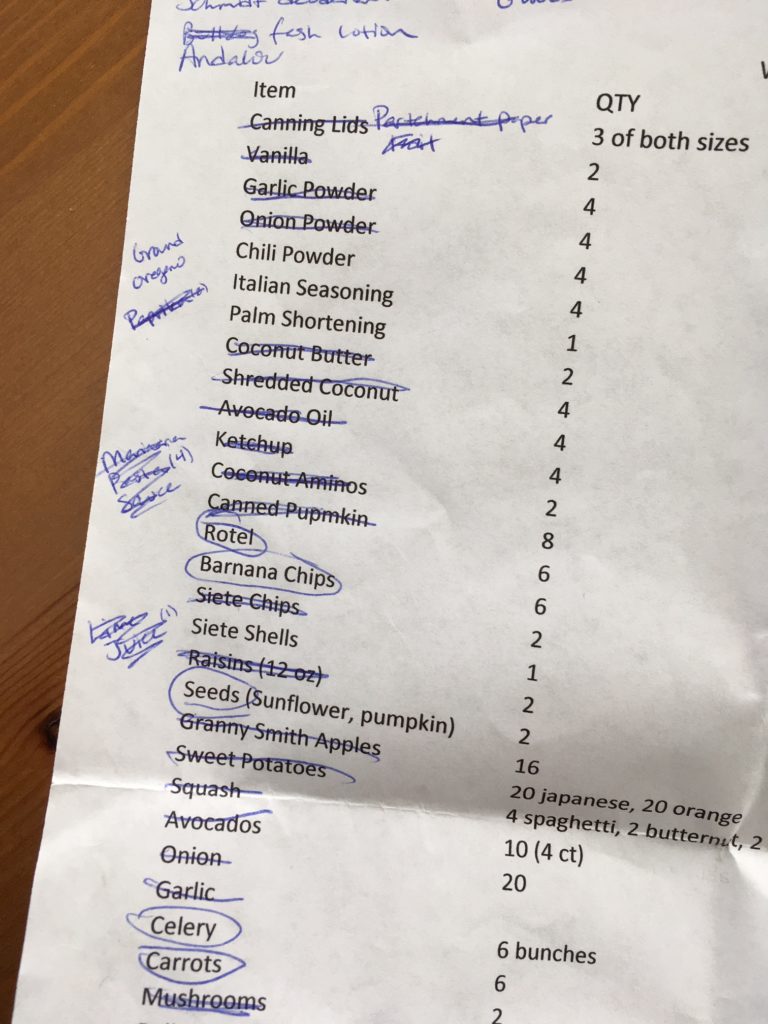
Meal Plan Preparation: What Tools Do You Have?
I’m going to start by saying that stocking up on two months of food, like we did, will not be possible for everyone.
But that doesn’t mean that you can’t do something!
In our house, we have two fridge/freezers as well as a freezer chest in the garage.
WHOA, some of you are saying.
And I get it, not everyone has that kind of storage space.
But that just means you have to shift your strategy.
For example, I bought lots of frozen vegetables.
Don’t have the freezer space? Stock up on canned goods instead!
My main advantage for stocking up for two months is my freezer space.
I bought loads of vegetables to chop and freeze.
I also bought other foods to can with my pressure cooker – again, a tool I know not everyone has.
But take a look around your kitchen and think through what you DO have!
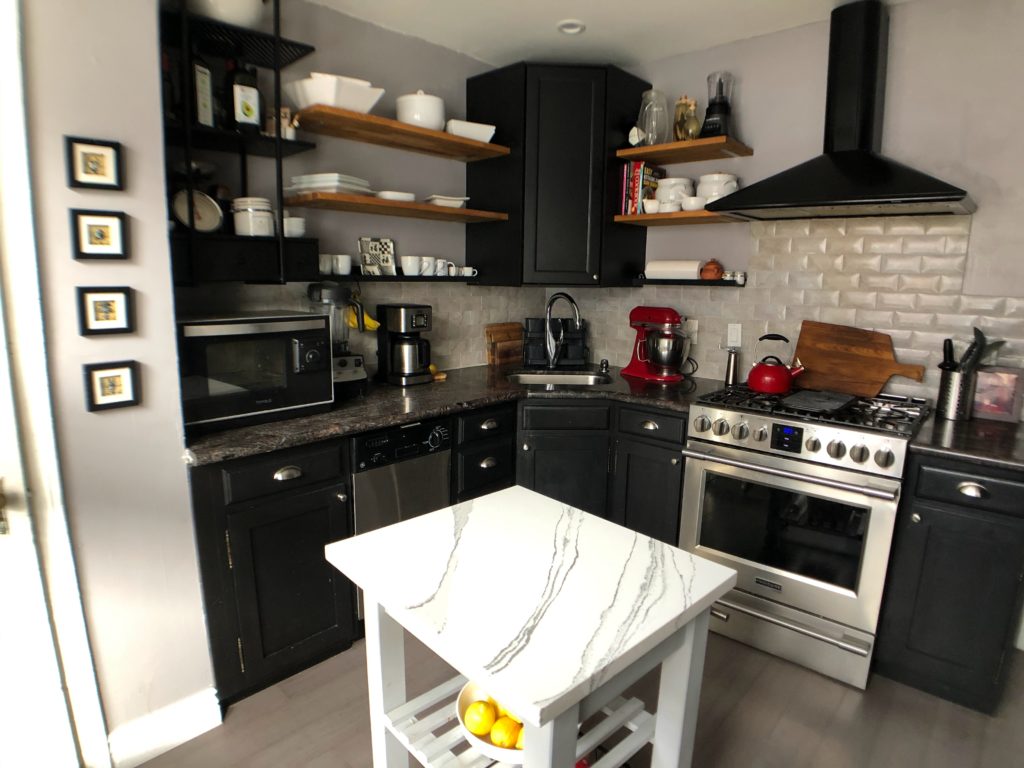
Do you have a dehydrator? Or even an oven??
Dehydrate foods to make them shelf stable for longer!
Need inspiration on what you can dehydrate?
Check out this list of over 101 ideas of things to dehydrate!
Is it summer and you have a grill?
Plan easy meals where you grill your meat and sides on hot summer days when you don’t want to cook anything!
Do you have an instant pot or a slow cooker?
Why not prepare a month’s worth of instant pot or slow cooker meals all at once so that you have lots of dump and run recipes ready to go.
Other kitchen tools to keep in mind are immersion blenders, regular blenders, food processors, griddles, waffle makers, toaster ovens, and toasters.
And even without ANY kitchen tools, there are shelf stable foods that you can purchase to limit the number of trips you have to take to the store.
Again, think canned, bagged, or frozen foods to supplement the fresh foods that you will quickly run out of.
How to Make Your First Meal Plan
Before going on a large store run, you need a plan.
The best place to start is to make a list of the recipes you would like to be able to make over the coming weeks.
What recipes does your family like the best?
And get the whole family involved – ask everyone what their favorite meal is!
Work together as a family to create a great line up of recipes everyone will enjoy!
This will help determine what ingredients you need.
I also tried to keep in mind that I want recipes that have more shelf stable vegetables like sweet potatoes, squash, and carrots.
Recipes that have canned foods are also great too!
Think of canned foods like olives, green beans, diced tomatoes, tomato paste, pasta sauce, and pumpkin.
A recipe list will also help you evaluate things you might forget about, like your spice cabinet – do you have enough salt? Garlic powder? etc.
Here you can see where I jotted down the first few recipes that came to my head.
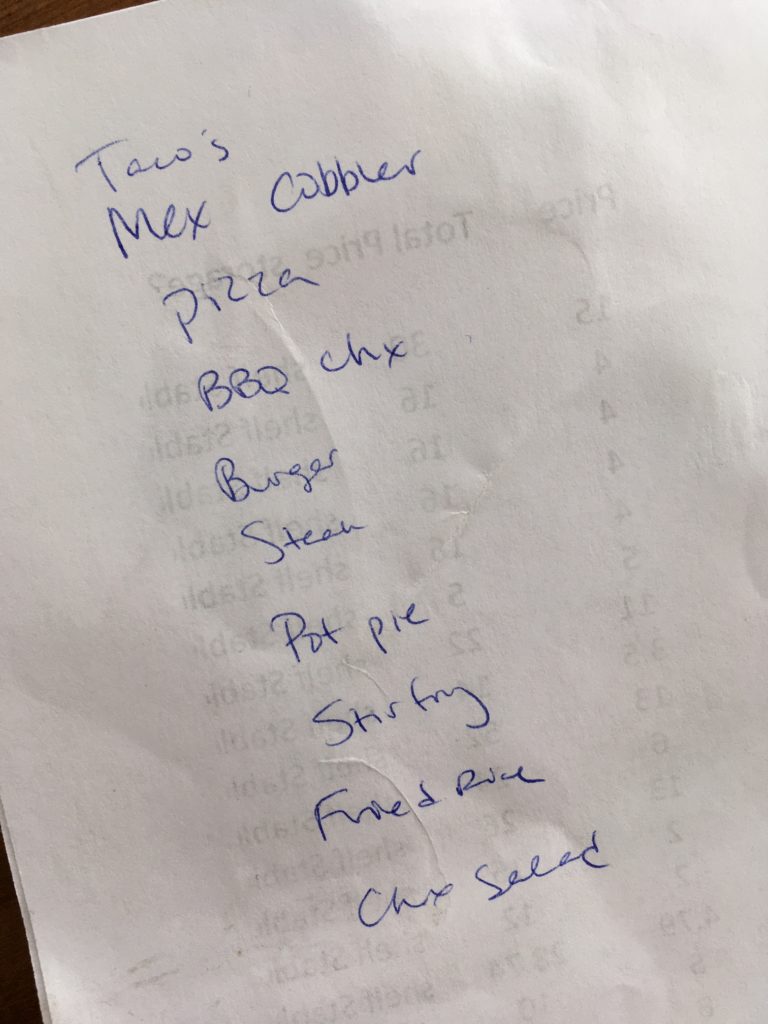
This is what my recipe list looked like when I was done:
Breakfast:
- Scrambled Eggs and Bacon
- Tomato Basil Egg Casserole
- Fluffy Egg Casserole
- Mexican Hash Casserole
- Apple Sausage Hash Casserole
- Pancakes
Snacks:
- Protein Bites
- Chocolate Bananas Muffins
- Peanut Butter Muffins
- Olives
- Chips – Barnana and Siete
- Homemade Trail Mix – seeds, coconut flakes, raisins, and chocolate chips
- Fruits
- Shelf Stable: apples, bananas, mandarin oranges
- Eaten Sooner: pears, berries, grapes?
- Veggies
- Carrots, cucumber, celery
- Smoothies
- Frozen Fruit
- Protein Powder/Collagen
- Coconut Milk
Lunch/Dinner (since we will all be home, I treated these categories the same):
- Tacos
- Fajitas or Fajita Casserole
- Mexican Beef Cobbler
- BBQ Chicken Casserole
- Spaghetti Squash Fried Rice
- Chicken Salad
- Stir-Fry
- Burgers (grill)
- Steaks (grill)
- Chicken (grill)
Sides:
- Broccoli
- Green Beans
- Asparagus
- Brussel Sprouts
- Mashed Cauli-tatos
- Baked Sweet Potatoes
Organizing Your Meal Plan into a Calendar
Now that you know what recipes you want to make, start to lay out a rough sketch of a weekly meal plan for the next month or two.
If you make X recipe, how many meals will you get out of it?
A pound of taco meat in our house lasts two meals, but if you have a family of 6 or 8, that’s not going to go very far!
Do you need to make a double or triple batch so it lasts a couple of days?
How many days can you eat X in a row before people will get sick of it?
I mean scrambled eggs are easy to make, but we can only eat scrambled eggs a few days in a row before my husband and toddler are asking for other choices.
By making a rough guess at what a month of meals looks like for your family, hopefully you can also synergize your list.
I like to put meals together in the same week that use some of the same vegetables, that way I can chop it all at once.
For example, this week we are having chicken salad and stir-fry.
That means that I can chop onion, celery, carrots, and bell pepper for both recipes in the same go.
Pair up your recipes so that you get more for less effort!
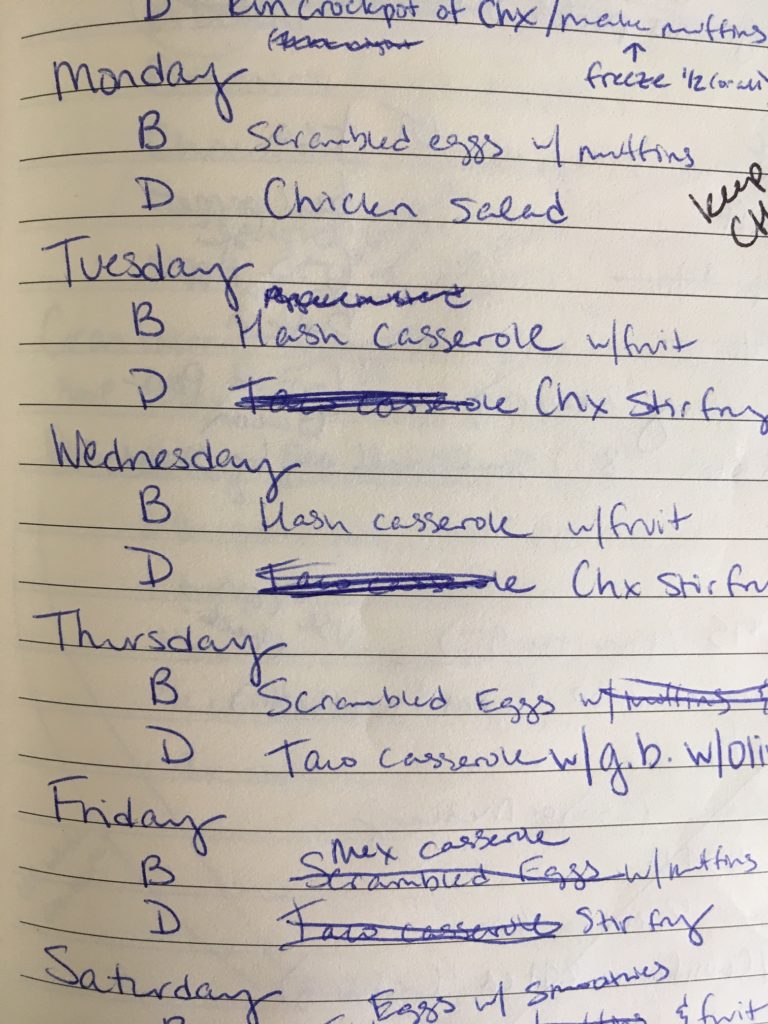
Or if you are more of an Excel nerd, make your calendar in Excel so that it’s easier to move meals around!
You can also use copy and paste to your advantage!
Here’s an example of what my Excel meal plans look like:

Making Your Meal Plan into a Grocery List
So now that you know what recipes you want to make, you are ready to form that grocery list!
For me, I’m an engineering nerd, so that meant making a list in Excel with all of the foods I needed to buy and what quantity I was hoping to get.
For those of you who don’t like Excel, paper and pencil will be fine for this exercise!
Start by making a list of all the ingredients you need.
Only list each ingredient once, and then as you run across ingredients that are used in multiple recipes, start a tally next to the item.
For example, I use diced onion in almost every recipe.
So I write down onion once, but then as I sort through my recipes, I start tallying up how many onions I will need for all of my recipes.
Once the list is complete with everything you need, check to see what you already have in the house.
This meant checking my freezer, pantry, and spice cabinet for what foods I already had versus what I still needed to purchase.
Now you need to split your list up by store (if you shop at multiple stores).
Try to limit the number of stores you have to go to since cold groceries will have to sit in the car.
I also highly recommend packing a cooler with ice for all of the cold things that you will buy at the first store.
So I narrowed down my lists to shopping on Amazon, and then running to Whole Foods and Costco.
My husband was planning to make a trip to Wal-Mart later, so I also knew that I had his trip as a backup for anything I couldn’t find on my trip.
Here’s a snapshot of what my list looked like:
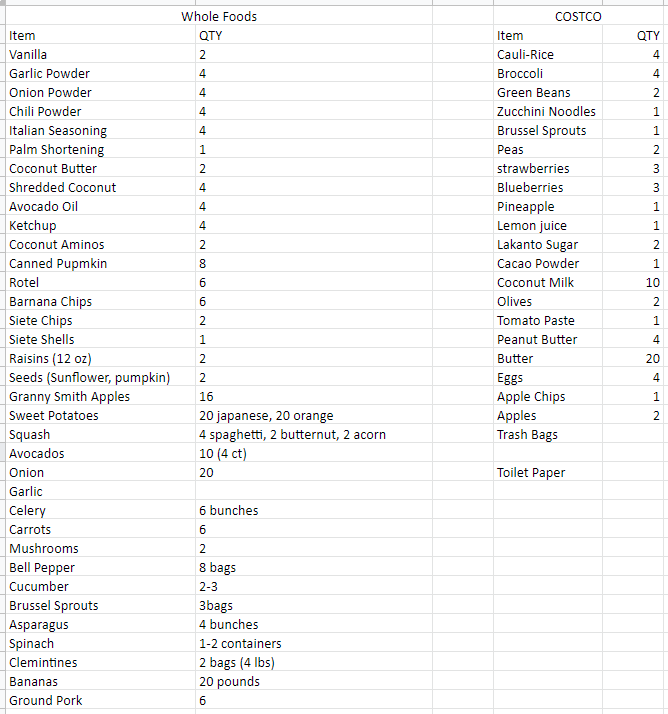
I also find it really helpful to reorder my list to group foods together into categories.
I try to put all of my inner aisle items together – think all of your pre-packaged foods.
This includes all of your canned goods, bagged foods, baking items, and spices.
Next I will group all of my produce together.
Then working my way around the store, I put down the meat and dairy products I want to get, that way I grab my cold items near the end of the list.
And last, I grab my frozen items.
This keeps the cold stuff cold the longest!
But only you know your store and your normal “route”.
Just make sure to lay your list out in a logical way.
Then you won’t forget to buy cucumbers while you are in the produce section and prevent yourself from having to do needless laps around the grocery store to get everything on your list.
Staying on Budget: How to Make Meal Plan Substitutions
Now you have a list together of everything you need to feed your family for one, two, or maybe even three months!
Aaaaaaaand you are thinking in your head that this is going to cost A LOT.
Hopefully you have a budget for your finances laid out and have planned a monthly budget for groceries.
If you don’t have a budget, a good rule of thumb would be to spend 10-15% of your income on food.
For me, it was helpful to add a couple of columns to my excel sheet to help estimate what the cost of this mega-shopping trip was going to cost.
I used previous receipts and searches on different store websites to add up cost information.
So I added one column for the price of 1 unit of each item.
I then used a second column to do the multiplying for me – multiplying the quantity I wanted by the cost per unit.
At the bottom of the list, I used the SUM function to add everything up to get my total cost.
This is what my sheet looked like after adding together that information.
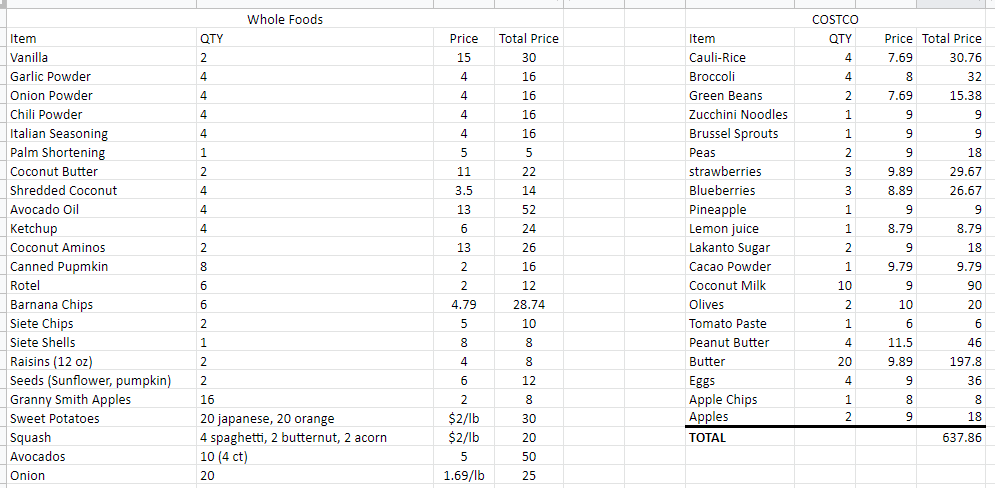
Now you are probably thinking to yourself, what do I do if my list is way more expensive than I can afford right now?
This is where it’s helpful to make substitutions for cheaper ingredients.
For our family, this is why we eat more beef than chicken – in our area, organic beef is cheaper than organic chicken.
Eggs are also a great protein source that won’t break the bank.
For ALMOST any recipe, you can sub out the meat for any other type of protein, or you could even save money by going meatless.
Stir-fry, for example, has such great flavor and so many veggies and healthy fats that you could leave the meat out to save money.
This is also why I stocked up on bananas – bananas are about the cheapest per pound organic fruit that I can buy in my area.
I also try to buy bulk whenever possible, such as shopping at Costco, since their prices are cheaper.
And at the end of the day, maybe you can’t buy all of the snacks you wanted or make all of the fun treats that you planned to because you need to cut a few things from the list to keep your budget on track.
You have to keep in mind that this WHOLE list, in general, is really a wish list anyways since you might run into the dreaded “out of stock” sign at the store.
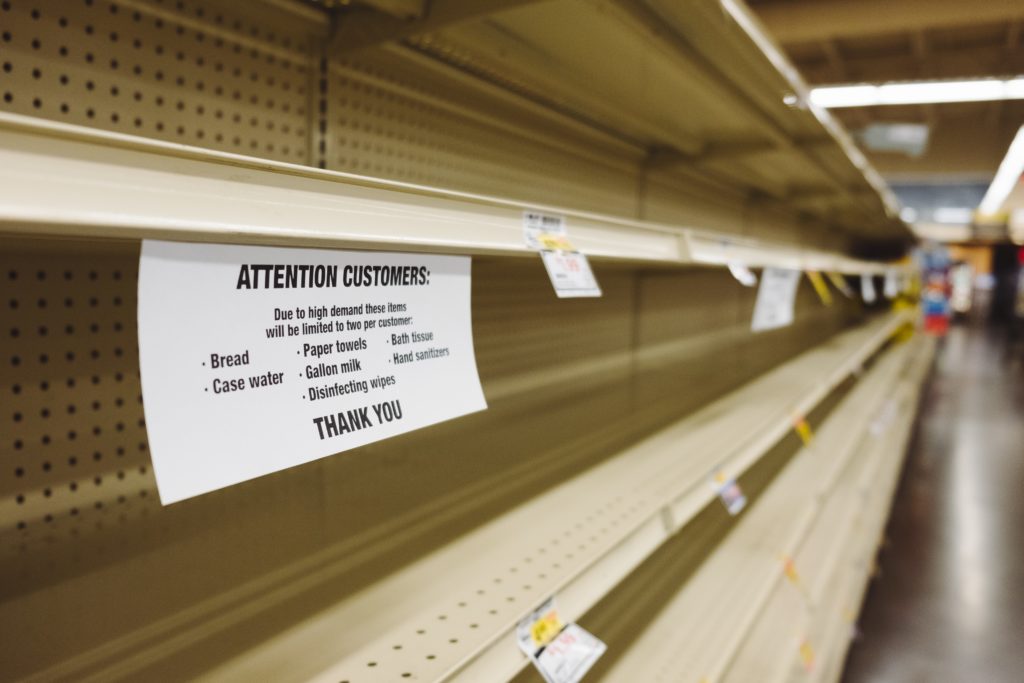
How to Plan for “Out of Stock” While Grocery Shopping
Having a list of exactly what you need will help you to stay on mission and be efficient.
But even the best laid plans can have setbacks.
Keep in mind that stores might be out of an ingredient that you need.
Consider your grocery list to be more of a “wish list”, and then be flexible once you see what your stores have in stock.
For example, I was hoping to load up on frozen cauli-rice from Costco, but if they were out, I knew in my head that I could look for heads of fresh cauliflower or buy extra sweet potatoes at Whole Foods instead.
Perhaps you wanted zoodles but they don’t have any – do they have fresh zucchini instead?
Maybe the store is out of the coconut flour you buy – can you buy it on Amazon instead?
You have to mentally have some swap-outs ready in your head, that way you can pivot on the fly.
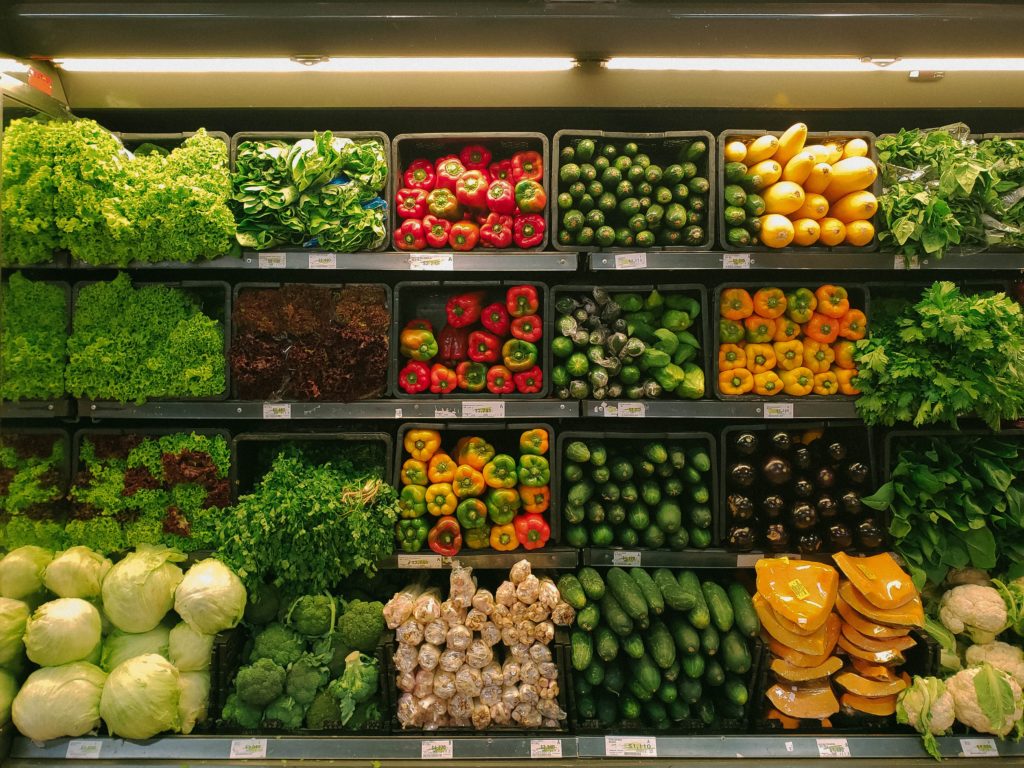
Becoming a Meal Plan Pro: You Can Do This!
Creating a meal plan for one, two, or even three months can take a lot of time, energy, and preparation.
But it will be worth it!
I put my plan together in about 3 days.
If you aren’t in a habit of planning for your grocery trips, this exercise might take you longer.
Give yourself breaks in your planning.
I find that sometimes stepping away and coming back to the list will remind me of a recipe I love or haven’t made in a while.
Sometimes I think of other ingredients that I also want to have on hand even though I don’t have a particular recipe in mind.
And if two months is too much for your first time, start smaller.
If you are running to the grocery store every day, try to plan out one whole week.
If you are used to buying groceries weekly, see if you can push yourself to planning out a few weeks or maybe even a whole month.
Make adjustments as you go!
Each time you go to the store, try to make it a little longer before your next grocery store run!
Knowing how to make a meal plan can be tricky, but all it takes is a little practice to become a meal plan pro!
You can do this!
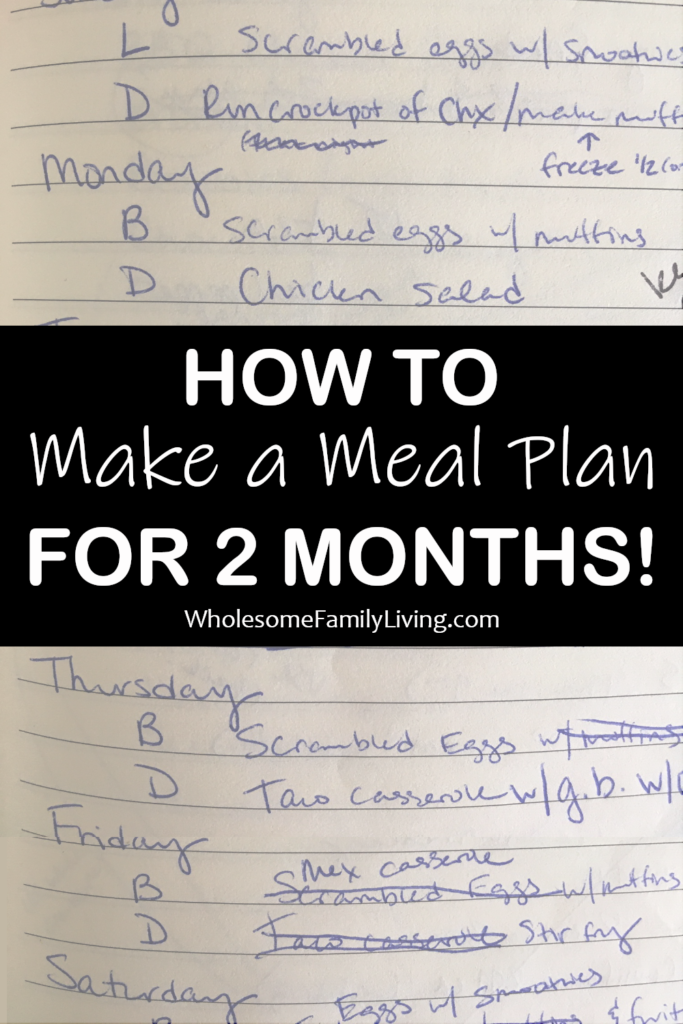
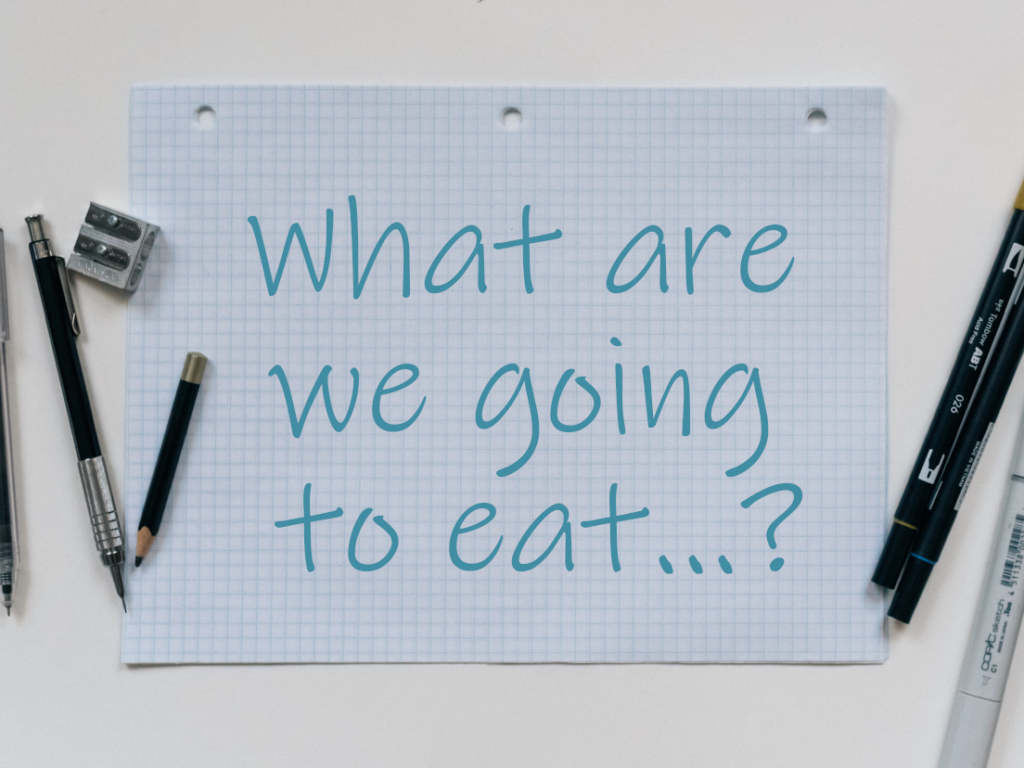



Kelsey Opiyo
May 9, 2020 at 5:18 amThank you so much, Jenny! This was helpful and I will try some of your new methods. As promised, thought I would share a few of my tips and tricks about living on the mission field in Uganda! (Many might not be relevant to many of you, but nonetheless, they could be interesting 🙂 )
Let me start by saying, based on income uncertainty, space, and supermarket limits, we prep for no more than a month at a time. Usually 2 – 3 weeks.
1. I ALWAYS keep large sacks of dried beans, dried silverfish (little minnows would be how I would best describe), and maize flour (for making what they call posho). These are some of the staple local foods. Great go-tos when we lose solar power for a little while and food spoils or when the heat or rats or insects unknowingly spoil things.
2. Culturally, visitors can show up at any time (and do!). No calling ahead, no warning. When this happens, it is also expected that they don’t leave your home without something to eat, however little! This certainly doesn’t help for meal prep, but it can be a beautifully Biblical thing (for a whole other discussion)! Thus, every week, I always keep a container of pre-boiled beans in the fridge, either to supplement a meal I already have prepared (if I think they will like the western food) or I just go ahead and fry up the beans and serve that to them instead. This container of beans is always good for meal supplementing for ourselves as well.
3. I also always keep at least one frozen meal in the freezer so that as previously mentioned, if food doesn’t turn out properly or gets spoiled, there is a quick back up!
4. Fortunately, many things here are truly straight from the garden and so many people just sell basic produce (tomatoes, onions, carrots, green pepper, etc) straight from their personal garden. This is super helpful because I can walk less than five minutes and reach several little market stands for buying basic produce. OR here there are also motorcycle taxis (called bodas) and I can easily call up a trusted one and send him to the local market for any last minute needed goods and he delivers straight to my door. So helpful!
Thanks for reading. Happy to share 🙂
Monster Cookie • Post Author •
May 13, 2020 at 6:48 amI’m glad the article was helpful Kelsey! It’s really interesting to hear about your food supply, grocery shopping, and cultural norms in Uganda! While I am used to many of my American comforts, it does sound really cool that there is so much fresh, local produce available from everyone selling from their gardens! And the bodas sound like our Instacart delivery service lol 🙂 Thanks so much for sharing Kelsey!